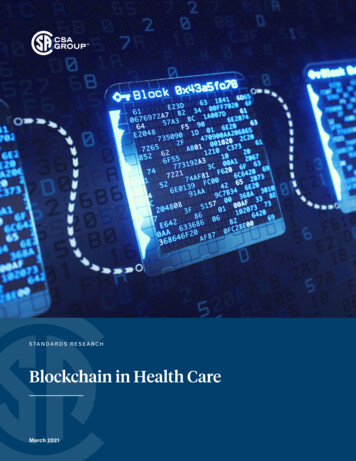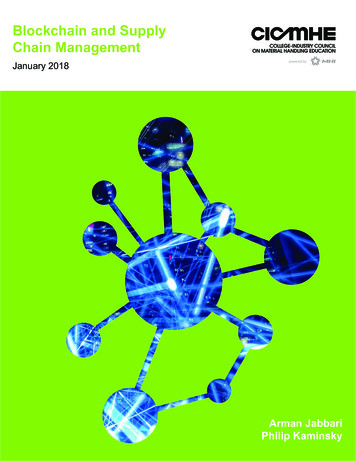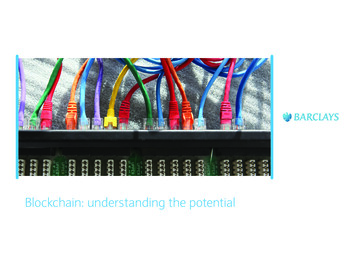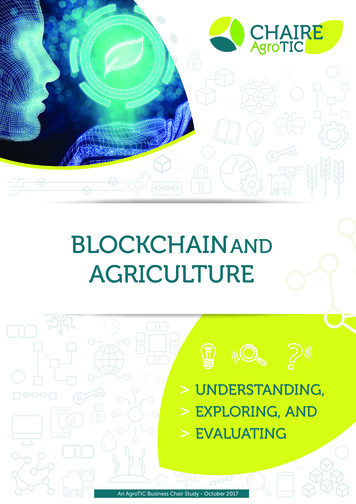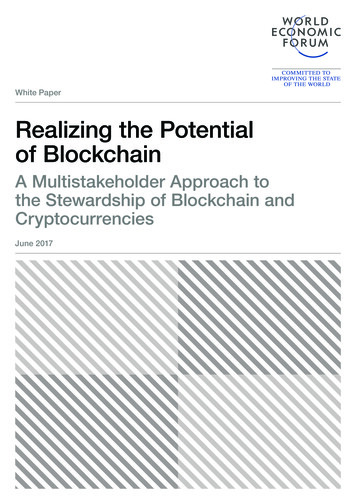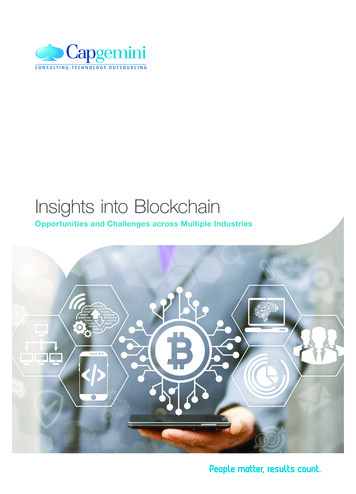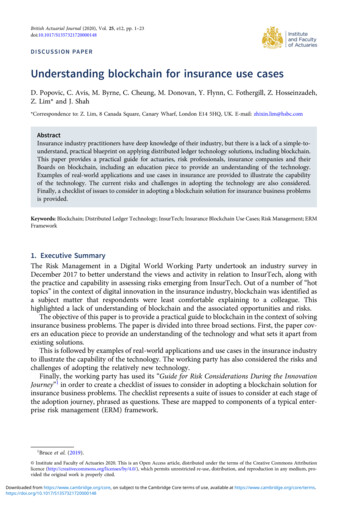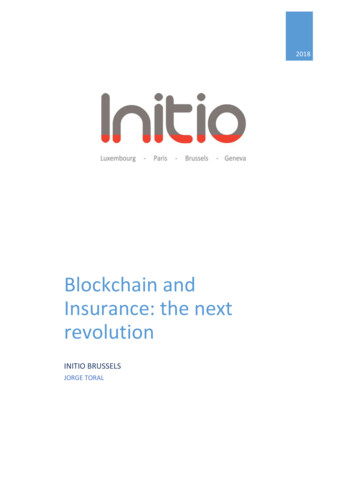
Transcription
2018Blockchain andInsurance: the nextrevolutionINITIO BRUSSELSJORGE TORAL
SummaryBlockchain and Insurance: the next revolution . 2Blockchain in a nutshell . 2Belgium: moving full digital for car insurance . 3Why moving fully dematerialized? . 3Expanding the usage of Blockchain technology for Insurance companies . 4About Initio . 6The author. 6Contact . 7
Blockchain and Insurance: the next revolutionBlockchain is a distributed ledger that is broadly discussed as a technology with huge innovationpotential in all areas of financial services. To date, the majority of usage cases of this technology arein the banking arena. We can refer to several publications available on Initio’s blog regarding theimpact of blockchain technology and the usage of crypto currencies in financial services.However, the blockchain technology also offers potential use cases for insurers that include innovatinginsurance products and services for growth, increasing effectiveness in fraud detection, pricing andreducing administrative cost. In these application areas insurers could address some of the mainchallenges they are facing today – such as limited growth in mature markets and cost reductionpressures.While the insurance industry (in terms of technology adoption) lags behind banking, it is neverthelessuniquely positioned to benefit from blockchain technology. Blockchain can address the competitivechallenges many incumbents face, including poor customer engagement, limited growth in maturemarkets, and the trends of digitization. In the following, we will outline one of the most promisinginsurance-related use case that will increase effectiveness and reduce cost by automating keyprocessesFor several years, the Belgian insurance market was behind on the digital revolution while bankingsector had been working hard in digitalizing their services across entities and platforms to meet thedemand from users for a full digital financial experience. Insurance companies have been delaying thisevolution while controlling their risks and focusing on their profits. The digital evolution was mostlyaimed at improving the digital process for their main selling channels: brokers and banks. They havetherefore developed platforms to ease the process for subscriptions, customer management, financialintegration and reducing paper works. In addition, some companies have developed mobileapplications allowing users to see their insurances or contact their company for claims. Theseapplications did not meet the expected success amongst final customers and are not even updated tofollow the actual digital market trends.Blockchain in a nutshellA blockchain is a distributed register to store static records and/or dynamic transaction data withoutcentral coordination by using a consensus-based mechanism to check the validity of transactions. Asthe Bitcoin backbone, blockchain was the first-ever solution to the double-spending problem that doesnot require a central administrator or clearing agent. It is thus well suited for applications requiringtransparency on records with a permanent time and date stamp, such as titles, document histories,and notary services. A blockchain solution, without requiring central coordination, generally builds ona set of four characteristics:1. Decentralized validation: New data is packed into blocks that can only be added to theblockchain after consensus is reached on the validity of the action.2. Redundancy. The blockchain is continuously replicated on all or at least a group of nodes inthe network. As a result, no single point of failure exists.3. Immutable storage: Each stored block is linked to its previous block in the chain, making italmost impossible for hackers to subsequently change blocks, as they would have tomanipulate any succeeding block plus the majority of their replications.
4. Encryption: Digital signatures based on pairs of cryptographic private and public keys putnetwork participants in a position to authenticate which participant initiated a transaction,owns an asset, signed a (smart) contract, or registered data in the blockchain.With these characteristics, in general, blockchains can be used as a system of static record keeping,and as a dynamic registry for the exchange of assets and payments as well as for the verification ofdynamic information (e.g., insurance contracts).Belgium: moving full digital for car insuranceWith almost 6 million cars for Belgium in 20161, the car insurance business represents the biggest partof the non-life insurance business with a weight of 3.738 Mio Euros in 20162. The most visible part ofthe car insurance business is the green card, which is the mandatory proof of insurance. Insurancecompanies are issuing paper green cards upon payment for an insured period (monthly, quarterly ).A recent change in the Belgian legislation has set the first step for a digital revolution. Since January2018, Belgian legislator has removed through Arrêté Royal (A.R.),3 the fact that payment of insuranceshould be done before the issuance of the green card. This legislation change will allow Insurancecompanies to issue green cards with a standard validity (mostly one year) nevertheless the paymentterms of the customer. This evolution will now reduce drastically the number of green cards issued bythe insurance companies.The following step will allow insurance companies to issue electronically the proof of insurance. As formany official documents, this will allow customers to choose receiving the green card electronicallyand being able to print it home on white paper or just keeping it in an electronic format. This electronicstep will mean an easier procedure for customers who prefer to receive their official documents in anelectronic format. As this process will be optional for final customers, it will not fully eliminate paperbut it will significantly reduce the actual costs for the insurance companies. This new legislationadjustment will come during by the end of 2018.Why moving fully dematerialized?The benefits of fully dematerializing the green card are not only financial (reduction of costs relatedto issuance), but are also beneficial for customers and authorities. Belgian authorities like the Policeare using a centralized database called VERIDASS. This database filled with information from the DIV4and insurance companies, includes data related to the vehicle, its owner and insurance. Thisinformation is restricted to authorities and can only be accessed under certain circumstancesestablished by law. As well, the data is only accessible upon request and not in real-time for authoritiesmeaning having up-to-date information. The digitalization of the green card and the implementation1Source: FEBIAC - 2016Source : Assuralia3Arrêté Royal du 22/12/2017 : « Removed from the A.R. 13/02/1991: La délivrance de ce certificat estsubordonnée au paiement préalable de la prime correspondant à la période d'assurance prévue au contrat.L'assureur qui délivre le certificat sans attendre le paiement de cette prime renonce à suspendre la garantie età résilier le contrat pour défaut de paiement de la prime pendant toute la durée de validité du certificat. Celleci doit correspondre à la période d'assurance. »4DIV : Belgian organization in charge of vehicule identification2
of a new database using the blockchain technology will bring benefits to authorities but to finalconsumer as well.With a fully digitalized process, customers will no longer need physical proof of insurance in their cars.The Vehicle identification number (VIN) will be a unique identifier for the proof of insurance. Therenewal process will be easier and paper free: the new centralized database will be updated in realtime and data will be validated using the blockchain technology.Another benefit for the customer and companies will be the easy integration of claim declarationprocess. Insurance companies will be able to integrate the requested information and to check inapplications. Controls and information filling will be free of human errors and simplified for thecustomer. Existing applications like Crashform from Assuralia5 will be able to integrate all the requireddata. This application developed by the association of Belgian insurers enables motorists to report atraffic accident to the insurance companies immediately. Today, the QR code on the green card canbe used to automatically fill in the information related to the insurances company. With the blockchaintechnology, the data can be filled in using the VIN and can be validated instantly.The police will also be able to efficiently track uninsured cars. There are about seventy-thousand carsin Belgium that are not insured. The hassle-free controls and fraud tracking will be simplified forexample by using radars to track uninsured cars on the road using a real-time database.In the Netherlands, fully dematerialized solutions were already developed through the RDW6 platformusing blockchain technology. The RDW database allows users (professionals or individuals) to see alltechnical details of vehicles that includes the insurance validity information without divulging personaldata related to the insurance taker or car owner. Consumers can check the database and easily starta claim process for example. It is not only beneficial for consumers, but the controls from authoritieshad been drastically simplified with this database. Other countries like Switzerland are also workingon this type of centralized database using thesame blockchain technology. Belgium is on the path offollowing this evolution.Expanding the usage of Blockchain technology for Insurance companiesBlockchain technology offers the level of confidence and security required by insurance companies inmanaging the contracts and claim processes. Blockchain may reduce administrative/operations costthrough automated verification of policyholder identity and contract validity, auditable registration ofclaims and data from third parties (e.g., encrypted transaction of patient data between doctor andinjured party accessible by insurer to verify payment), and payouts for claims via a blockchain basedpayments infrastructure or smart contracts.Insurance companies should also start experimenting with the blockchain technology through otherapplications such as smart contracts to enable automatic management, risk controlled and efficientclaim management. For example, the usage of blockchain technology for smart contracts wherefarmers are insured for floods or long periods of drought. Blockchain technology can manage theweather information required within the contract terms through an Oracle, and proceed automaticallyto compensations after effective validation of the data. Oracle is an agent that finds and verifies realworld occurrences (e.g. weather forecasts) and submits this information to a blockchain to be used by56Belgian Association of insurance companiesNetherlands Vehicle Authority in the mobility chain
smart contracts. This fully automated process will reduce the usage of experts and automate internalprocedures for claims. No more declaration needed or data validation are required.For car insurances, smart contracts will allow companies to control more efficiently the damage costs.The claim information coming through a smart phone or even a connected car will already warn thecompany concerning the accident and the block chain oracle will be able to start the compensationprocess in some instances pre-defined by the insurance contract. Having validated contracts and datais therefore key in reaching this stage. Therefore, the development of digitalized green card is a steptaken by Insurance industry in Belgium to develop and implement this technology that will facilitateinsurers’ growth. Insurance companies will be able to grow by improving their customer’sengagement, enabling cost-efficient product offering and enabling the development of insuranceproducts related to the Internet of Things (IoT). The fundament of this success is its usage as adistributed and reliable platform for customer-controlled data, peer-to-peer (P2P) insurance andsmart contracts.Block chain is a digitization technology that could be of strategic interest for insurers. The biggestchallenges to its industry-wide implementation are facilitating collaboration between marketparticipants and technology leaders, succeeding in the operational transformation, and shaping astimulating regulatory environment. Laying the foundation to address these challenges today will putinsurance companies in a position to have at-scale block chain use cases and profit from thetechnology’s benefits in the next five years.Jorge Toral
About InitioInitio is a business consultancy firm specialized in the Financial Industry.Every day, our consultants contribute to the successful delivery of business projects by transferringtheir expertise to our client's management and internal teams.Initio operates in the financial sector, servicing a wide range of clients. Our offering is focused onbusiness consultancy combined with project methodology in order to assist our clients on the wholeproject cycle.We have offices in Brussels, Luxembourg & Geneva. Through close collaboration, we can react swiftlyon a wide scope of services in order to meet client needs rapidly with the highest industry standards.The authorSenior consultant at Initio, Jorge Toral had an extensive career in leadingprojects in sectors like banks, financial services, telecommunication andinsurance. With his extensive experience, he has been leading projectsthat improves the process and productivity of companies with a focus ondefining new business processes, implementing new services in moneytransfer, developing reporting tools from scratch, new technology orservices implementation and automatizing process.
ContactInitio LuxembourgInitio BrusselsInitio Geneva153-155 rue du Kiem - Entrée D8030, StrassenLuxembourgBoulevard Brand Whitlock, 60Brussels, 1200BelgiumRue du Commerce, 4Geneva, 1204GenevaTel: 352 277 239Email: luxembourg@initio.euTel: 32 (0)2 669 77 44Email: brussels@initio.euTel: 41 (0) 22 591 79 21Email: geneve@initio.euTwitter: @Initio euwww.initio.eu
Blockchain and Insurance: the next revolution Blockchain is a distributed ledger that is broadly discussed as a technology with huge innovation potential in all areas of financial services. To date, the majority of

